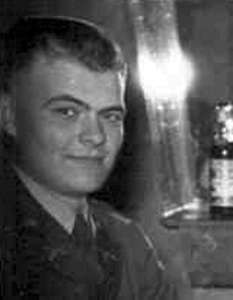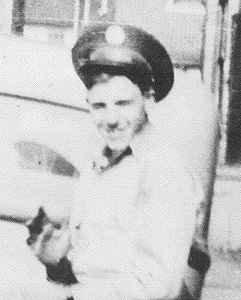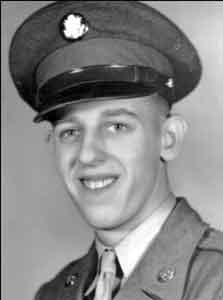Robert Clarence Niemann from Iowa, Bremer county.
Service era: Korea
Date of death: Unknown
 Death details: On July 5, 1950, Task Force Smith, the first U.S. ground element to engage North Korean People’s Army (NKPA) troops, was defending a position north of Osan, South Korea. The Task Force’s goal was to delay enemy forces by blocking their movement down the road south from Suwon to Taejon, which was a major avenue of advance for the NKPA. That morning, the Task Force was engaged by a column of enemy tanks. The anti-tank weapons that the infantrymen employed were ineffective, and a large number of tanks broke through their position. Task Force Smith was forced to withdraw to the south, suffering heavy casualties in the process. First Lieutenant Robert Clarence Niemann, who joined the U.S. Army from Iowa, served with C Company, 1st Battalion, 21st Infantry Regiment, 24th Infantry Division. His unit was part of Task Force Smith, and he was captured by enemy forces on July 5. He was marched north to a temporary prison in a schoolhouse in Pyongyang, where he died of dysentery on an unspecified day in mid-August. When U.S. forces gained control of Pyongyang in October, they buried 1LT Niemann in a temporary United Nations cemetery there; however, Pyongyang was retaken by enemy forces in December, and U.S. forces did not gain control the city again. After the ceasefire, 1LT Niemann’s remains were not identified among those returned to U.S. custody. Today, First Lieutenant Niemann is memorialized on the Courts of the Missing at the National Memorial Cemetery of the Pacific.
Death details: On July 5, 1950, Task Force Smith, the first U.S. ground element to engage North Korean People’s Army (NKPA) troops, was defending a position north of Osan, South Korea. The Task Force’s goal was to delay enemy forces by blocking their movement down the road south from Suwon to Taejon, which was a major avenue of advance for the NKPA. That morning, the Task Force was engaged by a column of enemy tanks. The anti-tank weapons that the infantrymen employed were ineffective, and a large number of tanks broke through their position. Task Force Smith was forced to withdraw to the south, suffering heavy casualties in the process. First Lieutenant Robert Clarence Niemann, who joined the U.S. Army from Iowa, served with C Company, 1st Battalion, 21st Infantry Regiment, 24th Infantry Division. His unit was part of Task Force Smith, and he was captured by enemy forces on July 5. He was marched north to a temporary prison in a schoolhouse in Pyongyang, where he died of dysentery on an unspecified day in mid-August. When U.S. forces gained control of Pyongyang in October, they buried 1LT Niemann in a temporary United Nations cemetery there; however, Pyongyang was retaken by enemy forces in December, and U.S. forces did not gain control the city again. After the ceasefire, 1LT Niemann’s remains were not identified among those returned to U.S. custody. Today, First Lieutenant Niemann is memorialized on the Courts of the Missing at the National Memorial Cemetery of the Pacific.
Source: National Archives, Defense POW/MIA Accounting Agency

 Death details: On July 5, 1950, Task Force Smith, the first U.S. ground element to engage North Korean People’s Army (NKPA) troops, was defending a position north of Osan, South Korea. The Task Force’s goal was to delay enemy forces by blocking their movement down the road south from Suwon to Taejon, which was a major avenue of advance for the NKPA. That morning, the Task Force was engaged by a column of enemy tanks. The anti-tank weapons that the infantrymen employed were ineffective, and a large number of tanks broke through their position. Task Force Smith was forced to withdraw to the south, suffering heavy casualties in the process. Private First Class William Reuben McGill, who joined the U.S. Army from Pennsylvania, served with B Company, 1st Battalion, 21st Infantry Regiment, 24th Infantry Division. His unit was part of Task Force Smith and he was captured by enemy forces two miles north of Osan. He was marched to the Apex prison camps in North Korea, and died of malnutrition and dysentery at one of the Apex camps in late December 1950. Although he was buried near the camp, his remains were not identified among those returned to U.S. custody after the ceasefire. Today, Private First Class McGill is memorialized on the Courts of the Missing at the National Memorial Cemetery of the Pacific.
Death details: On July 5, 1950, Task Force Smith, the first U.S. ground element to engage North Korean People’s Army (NKPA) troops, was defending a position north of Osan, South Korea. The Task Force’s goal was to delay enemy forces by blocking their movement down the road south from Suwon to Taejon, which was a major avenue of advance for the NKPA. That morning, the Task Force was engaged by a column of enemy tanks. The anti-tank weapons that the infantrymen employed were ineffective, and a large number of tanks broke through their position. Task Force Smith was forced to withdraw to the south, suffering heavy casualties in the process. Private First Class William Reuben McGill, who joined the U.S. Army from Pennsylvania, served with B Company, 1st Battalion, 21st Infantry Regiment, 24th Infantry Division. His unit was part of Task Force Smith and he was captured by enemy forces two miles north of Osan. He was marched to the Apex prison camps in North Korea, and died of malnutrition and dysentery at one of the Apex camps in late December 1950. Although he was buried near the camp, his remains were not identified among those returned to U.S. custody after the ceasefire. Today, Private First Class McGill is memorialized on the Courts of the Missing at the National Memorial Cemetery of the Pacific. Death details: On July 5, 1950, Task Force Smith, the first U.S. ground element to engage North Korean People’s Army (NKPA) troops, was defending a position north of Osan, South Korea. The Task Force’s goal was to delay enemy forces by blocking their movement down the road south from Suwon to Taejon, which was a major avenue of advance for the NKPA. That morning, the Task Force was engaged by a column of enemy tanks. The anti-tank weapons that the infantrymen employed were ineffective, and a large number of tanks broke through their position. Task Force Smith was forced to withdraw to the south, suffering heavy casualties in the process. Private First Class Myron Earl Gross, who joined the U.S. Army from Pennsylvania, served with B Company, 1st Battalion, 21st Infantry Regiment, 24th Infantry Division. His unit was part of Task Force Smith, and he was captured by enemy forces on July 5. He was forced to march to the Apex prison camps in North Korea, and died of dysentery and malnutrition at the camp at Chunggang-jin on an unspecified date in February 1951. His remains were not identified among those returned to U.S. custody after the ceasefire. Today, Private First Class Gross is memorialized on the Courts of the Missing at the National Memorial Cemetery of the Pacific.
Death details: On July 5, 1950, Task Force Smith, the first U.S. ground element to engage North Korean People’s Army (NKPA) troops, was defending a position north of Osan, South Korea. The Task Force’s goal was to delay enemy forces by blocking their movement down the road south from Suwon to Taejon, which was a major avenue of advance for the NKPA. That morning, the Task Force was engaged by a column of enemy tanks. The anti-tank weapons that the infantrymen employed were ineffective, and a large number of tanks broke through their position. Task Force Smith was forced to withdraw to the south, suffering heavy casualties in the process. Private First Class Myron Earl Gross, who joined the U.S. Army from Pennsylvania, served with B Company, 1st Battalion, 21st Infantry Regiment, 24th Infantry Division. His unit was part of Task Force Smith, and he was captured by enemy forces on July 5. He was forced to march to the Apex prison camps in North Korea, and died of dysentery and malnutrition at the camp at Chunggang-jin on an unspecified date in February 1951. His remains were not identified among those returned to U.S. custody after the ceasefire. Today, Private First Class Gross is memorialized on the Courts of the Missing at the National Memorial Cemetery of the Pacific.